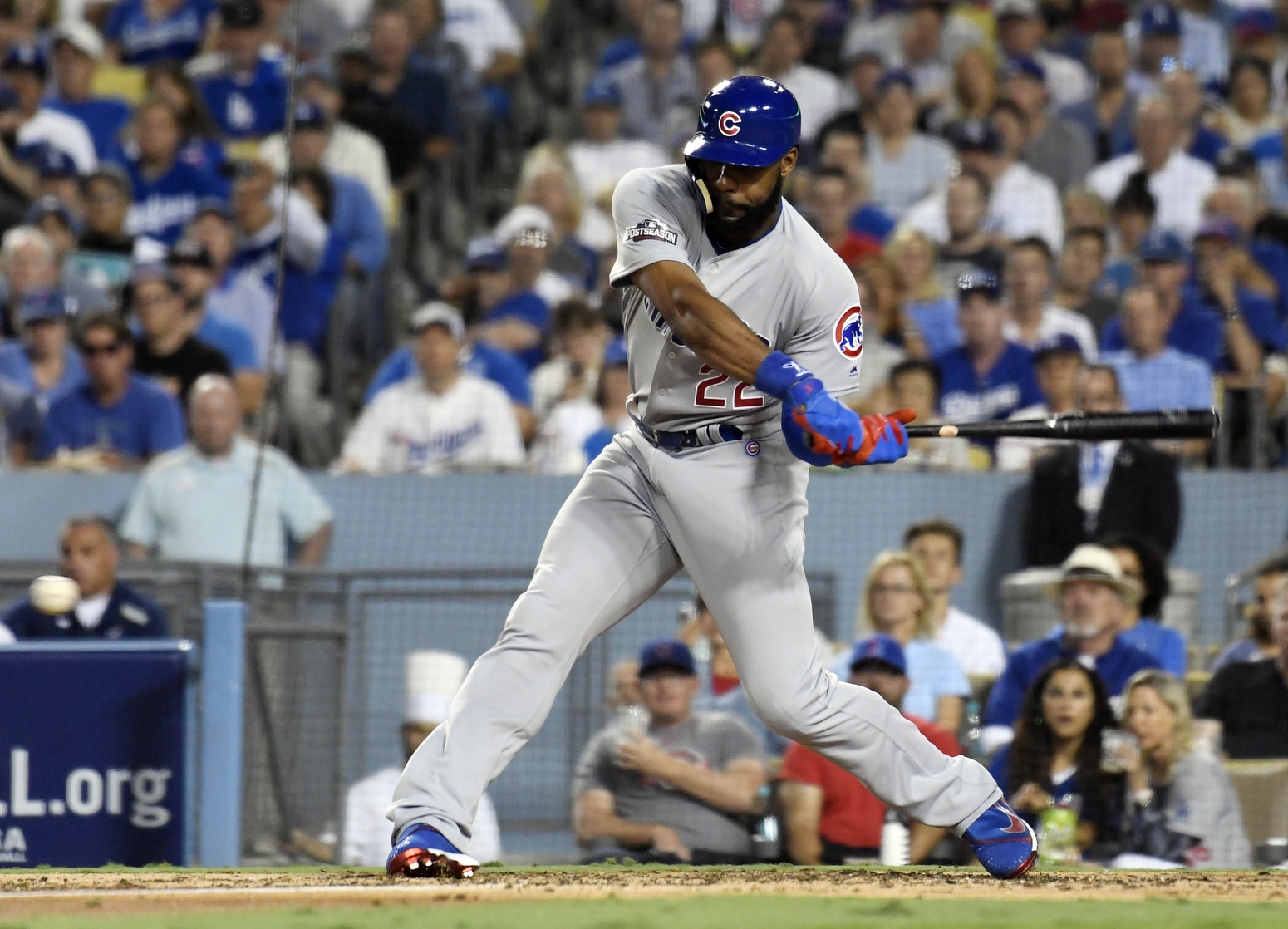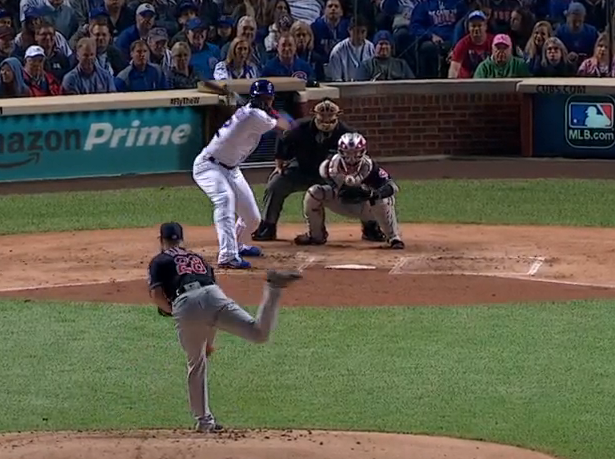[NOTE: Social media videos are hyperlinked, not embedded, for ease of navigation.]
There is a smoldering crater where Jason Heyward’s 2016 was supposed to be.
Line them up: a series of solid .285-ish TAv seasons, highlighted by moderate power, stolen base totals in the 20s, and league-best fielding gave way to a vast chasm of -0.2 WARP, spearheaded by a clunking .237 TAv and featherweight slugging. The content factory ground out pieces about Heyward like clockwork. Heyward’s mechanics are out of sync, Heyward is facing the pressure of his huge contract, Heyward will rebound soon, etc. Ultimately, the outfielder floundered at the plate all year, and never tacked toward a more productive course. It became apparent that Heyward’s retooling must be an offseason project, and that 2017 would be a key year in not only his Cubs career, but his career writ large. After all, he has a pair of opt-out clauses after 2018 and 2019 that all but guarantee that he tests free agency once more in his 20s.
It is clear, then, that Jason Heyward must seize the means of his production. We’ve already witnessed a smattering of evidence that Heyward is working on his hitting mechanics, and the circumstantial evidence—that he was extremely bad in 2016 and must get better for his own sake—pointed toward a major offseason project. Chris Cwik detailed some changes here. Likewise, Shiraz Rehman, Cubs assistant general manager, relayed that Heyward is working intensely with the Cubs’ hitting coaches on building the muscle memory that a swing rework needs.
We have some short videos from Cubs coach Darnell McDonald, posted to Twitter and Instagram over the past two months, of his work with Heyward on his swing this offseason. There is danger in amateurishly analyzing bits of video of a professional athlete who is surely trying a whole slate of different things, so one must be careful when drawing any conclusions without the proper training. Likewise, Heyward’s swing is a work in progress; what he looks like in December will be different from what he looks like in Spring Training, and in April. With that in mind, and knowing what we know about Heyward’s 2016 performance, I think it’s safe to make some tentative conclusions based on what has changed, with the assumption that he’s targeted specific areas for change. Let’s take a peek at those videos. I’ve put them all here at once because, while one short snippet of video tells us little, the few we have in concert with each other might point toward a trend in Heyward’s training.
https://twitter.com/MacDime54/status/811779560026951684
https://twitter.com/MacDime54/status/811780374242074625
https://www.instagram.com/p/BOOjVSDgf00/
(The last is courtesy Tim Sheridan, of Boys of Spring.)
The first key thing that I noticed, with my relatively untrained eyes, is Heyward’s front knee. Heyward’s 2016 swing featured an incredibly stiff front knee, extended to its full length even before he launched his swing. As a result, Heyward landed on the outer half of his right foot when planting, and his whole body drifted away from the strike zone (and the approaching baseball). Heyward’s eagerness to plant his foot negates any shift from back side to front side, an essential aspect of a swing, sapping all of the power from his swing. On some swings during the 2016 campaign, Heyward’s feet looked to be sloppily planted, kind of slipping all over the place, rather than firmly planted in front and pivoting in the back. All of these movements amount to an out of step lower half, generating little torque and, therefore, power.
For some visual analysis of this set of movements, watch this MLB Network video of Sean Casey:
Casey hits on the transfer of energy that Heyward lacked in his old swing, a product of his confused lower half. For a final assessment of Heyward’s lower half, watch this video of a single from the World Series:
Heyward singled on that swing. But if you look at this frame…
…I wouldn’t blame you if you thought he struck out on that 2-2 pitch. His butt is sticking out, his back leg has completely broken down and is at an awkward angle, and his upper half is in a very bad position to swing through the zone and make contact with the pitch, even though it’s a fairly meaty breaking ball from Corey Kluber.
The second thing that I noticed in the offseason videos is the difference in Heyward’s hands. Heyward is what many call a “long-levered” player, in that he has a lot of moving parts, and they can get out of sync easily. Take a look at his slowed down swing from his early Atlanta days, and note where his hands are in his set position, where they are as he loads up to swing, and how they come through the zone and make contact with the ball:
He has a short movement backward with his hands, his “load,” before moving forward toward the ball. It’s fairly compact. He abandoned that compact swing in 2016, resting his bat upon his shoulder prior to the pitch, fully wrapping the bat around his head during his load, and, because of the wrap, unleashing a longer, less controllable swing.
In the new videos, it looks as though Heyward is no longer wrapping the bat so far behind his head in his load up to swing. Rather, he’s keeping his bat a little more upright, his hands lower, and his right shoulder much more open to the pitcher. He gets the bat through the strike zone more quickly, as he doesn’t have to travel the far distance from behind his head. An added effect of his new hand position is his overall uprightness: whereas in his 2016 swing, his first movements were to crouch more and to wrap his bat, in the video McDonald provided, we see him moving his bat only slightly toward his body before exploding with his swing. With his more open shoulder, this allows his head to be “on” the ball longer, i.e. he can see it for a longer period and better put his bat in line to contact the ball.
Heyward used to hold his hands somewhere in the middle of where he is holding them in McDonald’s videos and where he held them in 2016. One notices that he moves his hands very little upon starting his swing, moving his body forward first and letting his hands follow naturally. In 2016, he moved his hands a lot; this offseason, it looks like he’s returned to the body-first, hands-follow swing of his Atlanta success. His hands start in a different spot, but load to much the same position.
And so, we’ve summarized the failings of Heyward’s 2016 swing, and his attempts to address it this offseason, split up by upper and lower halves. His lower half is “quieter” and more focused, as Heyward plants his front foot firmly and pivots his back foot, rather than breaking down on his back half and losing all momentum forward. Heyward’s hands are lower, and take a much shorter path from rest, to load, to swing, morphing the long path of his 2016 swing into a compact one resembling his successful Atlanta days.
Altogether, Heyward appears to have targeted a few problem spots in the sloppy 2016 swing that produced a sloppy 2016. It remains to be seen whether Heyward will go with these changes into Spring Training, and whether they’ll pay off with a more robust batting line. It’s difficult for Heyward to produce less at the plate than he did last season—to do so would be to relegate himself to the bench, despite his outstanding defense. I’m cautiously optimistic, however, that Heyward, a leader off the field, will return to form as a leader in the batter’s box as well.
Lead photo courtesy Richard Mackson—USA Today Sports


A full year of Schwarber and a minimum 3.2 WAR JeyHey is like adding two All Star free agents. If Baez and Addy improve with marginal improvement from AA, this could be one of the most exciting offensive clubs in recent history… we’ll see..
Did Tim Marx ever seize the means of production? http://m.bbref.com/m?p=XXminorsXXplayer.cgiQQid=marx–001tim&t=0